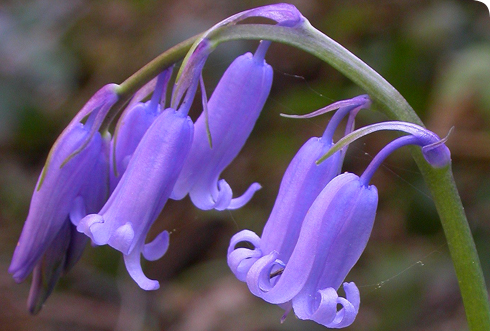Taxonomy
Morphology
- A perennial bulbous herb with flowering stems to c.50cm tall.
- Bulb 15-30 x 10-22mm, ovoid to globose, white with a brownish tunic, formed of coalescent scales which are renewed each year.
- Plants forms distinctive finger-like “droppers” when bulbs are disturbed which try to grow back down to an appropriate depth. Mucilaginous, the sticky goo produced when damaged has been used as a paste.
- Leaves all basal, rarely more than 6 produced, usually fewer, initially erect but flopping after flowering, up to 45cm long and 25mm wide, bright green on both sides, rather succulent, smooth, hairless, with a rather obtuse to somewhat pointed boat-shaped tip.
- The flower stalk is solid, erect, rounded in cross-section and rather brittle, persisting in fruit long after the leaves have disappeared.
- Up to c. 20 sweetly scented flowers are borne in a rather unilateral raceme, drooping at its tip initially but becoming erect later.
- Each flower is subtended by two linear-lanceolate bracts, the lower the larger, longer than the flower stalk. Rarely the bracts are highly developed (f. bracteata) giving an odd looking plant which is grown by lovers of the unusual.
- Flowers narrowly bell shaped, blue, white, or rarely pink – the last generally only in gardens or where garden-waste is tipped.
- Perianth segments (tepals) 6, in 2 whorls of 3, similar in shape, 14-22 x 3-4.5 mm, parallel sided, recurving at apex. 6 stamens, unequal, those of the inner segments shorter, inserted closer to the tepal base, all filaments fused to the perianth segments for more than half their length, the outer for about three-quarters of their length.
- Anthers with white-cream coloured pollen. The style is blue, shorter than the anthers, topped by a cream stigma.
- Ovary trilocular, giving rise to an ovoid, pointed capsule, 12-15 x 8-10mm.
- Seeds several per cell, black, glossy, rounded to ovoid, 2.5-3 mm.
Lectotype
designated by Stearn in Ann. Musei Goulandris 8:188 (1990)): Herb. Linn. No. 438.1 (LINN).
Basionym
- Hyacinthus non-scriptus L., Sp. Pl.: 316. 1753,
Synonyms
- Scilla non-scripta (L.) Hoffmanns. & Link
- Endymion non-scriptus (L.) Garcke
- Scilla festalis Salisb.
- Scilla nutans Sm.
- Endymion nutans (Sm.) Dumort.
- Agraphis nutans (Sm.) Link.
- Hyacinthus cernuus L.
- Scilla cernua (L.) Hoffmanns. & Link
- Endymion cernuus (L.) Dumort.
- Hyacinthoides racemosa Medic
